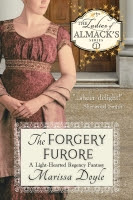 Summer’s almost here, though the weather does not seem to agree. Time for school to let out, people to go on vacation, nineteenth century young ladies to be in London for the Season. So, in between all those balls and parties, what did a well educated young lady do during her time in London? One favorite with tourists then and now is the British Museum.
Summer’s almost here, though the weather does not seem to agree. Time for school to let out, people to go on vacation, nineteenth century young ladies to be in London for the Season. So, in between all those balls and parties, what did a well educated young lady do during her time in London? One favorite with tourists then and now is the British Museum. In 1753, the physician and collector Sir Hans Sloane had bequeathed his collection of 71,000 books, antiquities, and natural artifacts to England, provided the country could offer suitable housing and pay his heirs 20,000 pounds. Parliament held a public lottery in 1755 to raise 21,000 pounds to purchase and repair Montagu House in Bloomsbury to hold the collection. Four years later, on January 15, the British Museum was opened to the public.
 Originally the museum held printed books and prints, manuscripts and medals, and a hodgepodge of other items, but slowly, through purchase and donation, the museum acquired a number of unique pieces such as an Egyptian mummy, drawings from Captain Cook’s three Pacific voyages, and a collection of ancient Greek vases. In fact, the wealthy delighted in donating interesting things to the museum, including the trunk of a tree gnawed by a beaver, a rock that looked like a petrified loaf of bread, and a live tortoise.
Originally the museum held printed books and prints, manuscripts and medals, and a hodgepodge of other items, but slowly, through purchase and donation, the museum acquired a number of unique pieces such as an Egyptian mummy, drawings from Captain Cook’s three Pacific voyages, and a collection of ancient Greek vases. In fact, the wealthy delighted in donating interesting things to the museum, including the trunk of a tree gnawed by a beaver, a rock that looked like a petrified loaf of bread, and a live tortoise.By the early 1800s, the museum was becoming more selective. It acquire the Rosetta Stone, various collections of classical sculpture, and portions of classical buildings like the Parthenon (the Elgin Marbles) and the Mausoleum of Halikarnassos. The collections also expanded to include artifacts from the Middle East and, under protests from national scholars, England. As the collections grew, so did the museum, expanding far beyond the original walls to the classical front visible today.
 With the museum free to visit, the trustees were concerned that the building would be overrun. So, to protect the collections, the museum issued a few tickets a day, for a set time of the day to visit. If you wished a ticket, you went to the museum and applied to the Porter at the front gate. The Porter set you down for a certain day and time, but you had to return to the museum another day to get the ticket and then again at your visiting day and time, somewhere between 9am and 4pm, Monday through Friday.
With the museum free to visit, the trustees were concerned that the building would be overrun. So, to protect the collections, the museum issued a few tickets a day, for a set time of the day to visit. If you wished a ticket, you went to the museum and applied to the Porter at the front gate. The Porter set you down for a certain day and time, but you had to return to the museum another day to get the ticket and then again at your visiting day and time, somewhere between 9am and 4pm, Monday through Friday. No more than five people were assigned each time slot. On the appointed hour, you met with one of the Under-Librarians, who gave you a guided tour. You started up the Great Staircase to tour the upper rooms, then descended to the ground floor for a tour of those rooms. You were not encouraged to linger over the marvelous sights. Each tour was quick and sharp, to make sure to leave room for the next group.
Hm, think that might be the origin of “And we’re walking”?





4 comments:
The British Museum is amazing. I attended school and worked near there for a semester and spent lots of time wandering the museum. We did get a guided tour by our professor but there's so much to see that it's impossible to do it all in one day. I can easily imagine the crowds of fashionable 19th century people being rushed through the museum trying to avoid rubbing elbows with the lower orders.
I quite agree, QNPoohBear. I've only had the opportunity to visit once, but I wanted to stay for days!
Interesting. Wonder what the museum did with that petrified rock? If I go back to England and visit the BM in the future, I should ask them about it!
Thanks for the fun article :)
You're welcome, Rachel! I wondered about the rock, but I also wondered about the stuffed giraffes. One of the pictures I saw of that grand staircase had two huge giraffes standing on the upper landing. Wonder what they did with those things when they remodeled? ;-)
Post a Comment